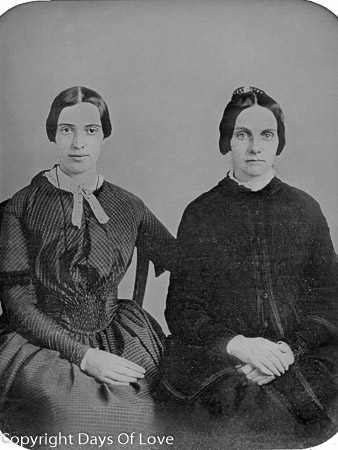

 Kate Scott Turner (March 12, 1831, Cooperstown, New York – 1917) was
a friend of
Emily Dickinson and a poet herself.[1]
She was also known as Kate Anthon. Recent scholars such as Patterson,
Lillian Faderman, and Woodul have argued
that Dickinson's "seemingly curious" life makes sense if seen from a lesbian
perspective that includes the many women who were close to her, such as
Sue Gilbert
and Kate Scott Turner.
Kate Scott Turner (March 12, 1831, Cooperstown, New York – 1917) was
a friend of
Emily Dickinson and a poet herself.[1]
She was also known as Kate Anthon. Recent scholars such as Patterson,
Lillian Faderman, and Woodul have argued
that Dickinson's "seemingly curious" life makes sense if seen from a lesbian
perspective that includes the many women who were close to her, such as
Sue Gilbert
and Kate Scott Turner.
Margaret Fuller's 1842 translation fo the correspondence between Karoline von Günderrode and Bettina von Arnim, two German writers who had loved each other at the beginning of the century, was the inspiration for many of the letters and poems written by Emily Dickinson to her friend Sue Gilbert. After Gilbert's marriage to Austin (Dickinson's brother), Emily fell in love with Sue's school friend, Kate Scott. Their romance lasted for a number of years, culminating in the summer of 1860, when they spent a night together. Emily commemorated this event in one of her poems (1862) to Kate, describing it as a symbolic marriage.
Catherine Mary ("Kate") Scott was the daughter of Henry Scott of Cooperstown, New York.[2] She attended the Utica Female Seminary, where in 1848 she met Susan Gilbert, who married Emily Dickinson's brother Austin Dickinson.[3] The women remained friends until Susan's death[4] in 1913.[5]
In 1855, she married Campbell Ladd Turner, who died in 1857 of tuberculosis.[2][4] Turner was acquainted with Emily Dickinson through Susan, and they remained so until the mid-1860s.[3] Turner married for a second time in 1866 to John Hone Anthon, who died eight years later. She died in 1917 in England, having lived most of her life outside of the United States.[2]
She met Emily Dickinson in 1859.[2] From that time until about 1862, Dickinson sent her four poems.[3] One poem was sent with a pair of garters that Dickinson had knitted for her:
When Katie walks, this simple pair accompany her side,
When Katie runs
unwearied they follow on the road,
When Katie kneels, their loving hands
still clasp her pious knee —
Ah! Katie! Smile at Fortune, with two so
knit to thee!
Emily Dickinson[3]
Dickinson developed "a revolutionary poetic style", according to a research paper by psychiatrist John F. McDermott,[6] following her relationship and rejection by Turner in 1861, which precipitated an emotional crisis and had a profound effect on her future work.[7]
My published books:
The bulk of Dickinson’s poetry has been divided into two distinct phases, separated by an “emotional crisis” in 1861. .... But in April 1861 Anthon sent Dickinson a letter ending their relationship. Dickinson was devastated... The breakup triggered Dickinson’s second phase of poetic productivity, marked by even greater creativity...Kindle version. Kindle locations 4313–4329.